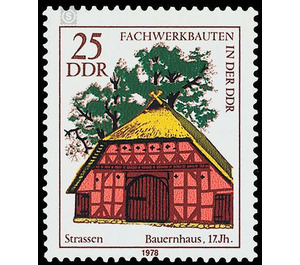Commemorative stamp series - Germany / German Democratic Republic 1978 - 25 Pfennig
Theme: Architecture
| Country | Germany / German Democratic Republic |
| Issue Date | 1978 |
| Face Value | 25.00 |
| Color | multi-colored |
| Perforation | K 14 |
| Printing Type | Rotogravure 2 |
| Stamp Type | Postage stamp |
| Item Type | Stamp |
| Chronological Issue Number | 2038 |
| Chronological Chapter | GER-DDR |
| SID | 392867 |
| In 22 Wishlists | |
Half-timbered buildings in the GDR With the illustrations of half-timbered buildings in the GDR, the Ministry of Posts and Telecommunications of the German Democratic Republic issues five multi-colored special postage stamps. Special cancellations from January 24 to March 23, 1978 Half-timbered buildings in the GDR The half-timbered building is one of the oldest techniques for building a house. Since the 7th century wooden buildings have been attested, which indicate a processing by trained craftsmen. The oldest surviving half-timbered houses are erected as stand buildings (eg Quedlinburg, Woord 3). With them, the load-bearing trussed stalks (the so-called stands) stand on a foundation wall or, as has become customary since the 14th century, on balance beams and Fußriegeln. The upper frame timber and the bars between the uprights form the necessary static framework. With the 15th century, the individual struts of the posts and finally the connection of entire half-timbered walls by corner posts developed. The design of the sections is historically and scenically different. One of the oldest forms is the clay straw filling. In the north, bricks were often used as filling masonry. Since wood is a rapidly transient building material, much has been lost from the formerly rich timbered architecture. All the more valuable today are the preserved wooden and half-timbered houses and the few half-timbered towns such as Quedlinburg, Wernigerode, Stolberg and Osterwieck. They are all four in the area, which since the 15th Century has the richest artistic expression of half-timbered architecture. In addition, remained in other landscapes, such. In Thuringia and Lusatia, for example, the tradition of woodworking and tradesmanship comes to life and, especially in the Thuringian area, it displays rich craftsmanship and folkloristic skills, as reflected in the magnificent carvings. 25 Pfennig value: streets, farmhouse The Low German farm holds all the necessary buildings and rooms under one roof: apartment, stable and barn. At the same time, the elongated building inside has an appropriate breakdown derived from the house construction. Strong uprights bear the crossbars on which the roof structure is stored. A large gate, through which the harvesting vehicle can enter, leads from the gable side of the house into the middle long room of the hallway or hall. The exterior of the house is artfully designed. The wooden construction has been clearly emphasized as a structured element. The compartments have been moved with bricks. Above the house gable, the deeply lowered thatched roof is closed horizontally by a crippled whale and projected far ahead. This farm is a typical example of this still existing in our northern districts farmhouses.


